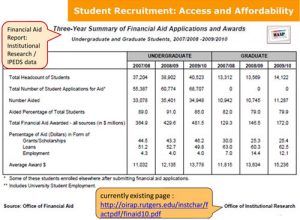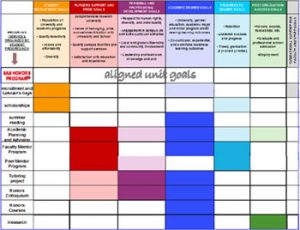Mission Alignment and Assessment Planning system (MAAP)
Overview and Description
The innovative Mission Alignment and Assessment Planning system (MAAP) is designed to document and assess the contributions of the many programs and units that play a role in the Rutgers-New Brunswick undergraduate educational experience mission/goals, and to facilitate and encourage assessment and alignment of outcomes and progress toward those goals. MAAP focuses on seven university-level undergraduate mission goals:
- Student Recruitment Goals
- Rutgers Support and Pride Goals
- Personal and Professional Development Goals
- Academic Degree Goals
- Progress to Degree Goals
- Post-Graduation Success Goals
- Operational Support for Faculty and Staff Goals
MAAP’s Purposes: Alignment, Assessment, and Planning
- Provides a visual display of the multiple ways in which each unit’s goals align with the University’s goals
- Recognizes unit success in meeting these goals by providing a portal to unit assessment data
- Facilitates planning by identifying under-met goals and cultivating synergies between units that all contribute to a particular mission goal
- While MAAP was initially developed in the context of a major reorganization of the undergraduate education schools and functions at Rutgers New Brunswick, the MAAP concept can be employed in virtually any domain within a college or university.
MAAP Process and Methods
The MAAP process provides an integrative strategy for and visual display of the multiple ways in which each unit’s goals align with the University’s goals and includes three main steps.
Step 1: Alignment
What are each unit’s goals? Which of those goals align with which of the University’s undergraduate educational experience mission goals?
- Each unit lists its activities or programs, and fill in where its goals align with University mission goals on a MAAP grid
- Deep colors identify primary areas of contribution and the focus of the unit’s assessment activities
- Pastel colors identify secondary areas of contribution
Step 2: Assessment
What evidence is there that the unit is meeting its aligned goals?
- Ideally each unit will have a web page listing its aligned goals and providing current assessment results.
- For many units, all that will be involved is creating a link to the assessment data they are ALREADY collecting!

- Some units will want to adjust their goals to better align with the University mission goals — this may then lead them to adopt additional or different assessment measures.
Step 3: Planning
How are the assessment results used to improve unit contributions to the achievement of the mission goals? What information does unit assessment provide about overall university success in meeting the mission goal? What synergies can be created between units that all contribute to a particular mission goal?
MAAP creates opportunities for units from across the university who contribute to the same mission goal to collaborate to increase the university’s success in meeting that goal.
Resources for MAAP participants
MAAP Powerpoint
The MAAP Powerpoint provides an overview of MAAP and detailed information about how to apply MAAP to a unit, department, or program

MAAP Grid – Undergraduate and Graduate
Excel spread sheet versions of the Undergraduate and Graduate versions of the MAAP grid

More information about MAAP
- MAAP at a glance
- MAAP presentation at National Consortium for Continuous Improvement in Higher Education
- MAAP paper presented at National Consortium for Continuous Improvement in Higher Education
- MAAP: An Integrative Strategy for Mission Alignment, Assessment, and Planning in Complex University Communities, by Susan Lawrence and Brent Ruben
MAAP Pilot Projects
As pilot units, Eight program areas at Rutgers came together in early 2012 to share their experiences and learn from each other. Pilot Units were invited to “…share your MAAP experience with the group, providing a summary of how MAAP is working in your unit, the progress you’ve made, challenges you’ve faced, solutions you’ve found, advantages to the MAAP approach you’re finding, and your plans for continuing to move forward.”
MAAP Presentation Summaries
University Office of Information Technology
OIT provided a narrative description of several programs which contribute to the University Undergraduate Education mission goals as listed in MAAP. One of particularly significant scope and reach is the IT student support staff training. The next step will be for OIT to identify particular university career readiness goals with which their student IT training aligns, and then to develop indicators that will allow OIT to assess and communicate the successes of these efforts. An additional next step will be the identification of other OIT programs and services which contribute to undergraduate education goals, and to identify indicators of effectiveness of these programs.
Public Safety
The MAAP project provides Public Safety with an excellent opportunity to identify, communicate, evaluate and improve several programs and services they provide which contribute to the university undergraduate education mission goals. A particular focus, in this regard, is the Community Service Officer (CSO) program, which provides extensive career readiness preparation for involved students. The next steps will be to develop methods for assessing the contribution of this program, and to identify any other programs that may also contribute directly to workforce readiness or other undergraduate education mission goals.
Office of Undergraduate Education: Dashboards
The Office of Undergraduate Education’s dashboards, originally developed for more generic assessment purposes, showed the links between on-the-ground unit activities and University level mission goals. Of particular note are the measures of how OUE’s local programs contribute to some of the widely-reported measures of institutional effectiveness such as retention rates. As OUE moves forward, the next steps will be to expand the number of its programs involved in this project and have each more clearly articulate how their program goals align with the University mission goals allowing them to document and continuously improve their important contributions to the undergraduate educational experience.
Student Affairs
Student Affairs is, by far, the largest unit participating. Their presentation illustrates how MAAP can be used and adapted within units to inventory and clarify the services provided by their programs and to think about how those services cluster around and align with a range of university mission goals, particularly in the areas of Personal and Professional Development and Rutgers Support and Pride Goals. As Student Affairs moves forward the next step will be for them to develop appropriate indicators and measures of success in meeting the particular mission-articulated goals of their specific programs.
SAS Office of Undergraduate Education
As the home for curricular oversight, development, and assessment in the School of Arts and Sciences, the SAS-OUE provides the kind of academic student learning outcome goal assessment that dominated the assessment and accreditation conversation in the late 1990s and the first decade of the 21st century. One of the prime advantages of MAAP is that it incorporates assessment of student learning outcomes into discussions that focus on admission profiles, retention statistics, and graduation rates as metrics of institutional effectiveness. By so doing, it keeps the defining purpose of higher education central and brings together the traditional instructional work of the faculty with the myriad of other university actors that advance the university’s undergraduate education mission goals. Much is to be done to advance SAS’s assessment of student learning goals in general education and in each specific major. One next step is to chart the alignment of SAS goals with the University’s learning goals. Moving forward SAS will develop a web page where assessment results can be linked to MAAP. An additional next step for SAS faculty is to look more explicitly at how their student learning goals, and their methods of advancing them, articulate with other university undergraduate education goals like Rutgers support and pride, personal and professional development, and career readiness.
SAS Office of Academic Services
The SAS Office of Academic Services is charged with multiple types of academic advising and lots of back-office processing of student files. OAS initially struggled with how to articulate its service goals with the university mission goals and how to measure effectiveness in any way beyond general, broad student surveys that, even at their best, would miss much of the invisible yet crucial work OAS does in maintaining the accuracy of student records of progress. After the pilot conference, SAS Office of Academic Services was able to go back to some of its leading programs and develop dashboards and narratives that give a tight picture of how OAS’s work contributes to the undergraduate mission. The next step for OAS will be to expand this work to all of its programs and functions, further specify the articulation between its goals and the university mission goals, and develop a web page of results linking to a central MAAP.
SAS Honors Program
The SAS Honors Program developed an online survey of its students with questions specifically keyed to their various activities’ contribution to MAAP mission goals. They have some pilot responses and plan to recruit many more of their students as survey respondents. This will provide the Honors Program with valuable data for both improving their activities and further articulating specific goals for each activity that aligns with the University mission goals. Some of these survey results will be used to create dashboards. The next step for the SAS Honors Program will be to develop direct measures of the mission-articulated goals.
RU Libraries
Rutgers University Libraries is integrating MAAP with their strategic planning process. As with other pilots, a critical step is to identify which RUL programs and services align with and support which undergraduate mission goals. The subsequent task is to clarify the best ways to evaluate and communication RUL’s success in these programs and services, and to identify and pursue opportunities for improvement. Setting and monitoring progress toward specific RUL goals, taking account of RUL aspirations, and historical and national comparisons will be a next step.
Rutgers MAAP Steering Committee
Co-chairs:
- Brent Ruben, Executive Director, Center for Organizational Leadership, Professor II (Distinguished Professor) of Communication
- Susan Lawrence, Dean, Educational Initiatives and Core Curriculum, SAS
Steering Committee Members:
- Graduate School of Education
Richard DeLisi - Rutgers Center for Organizational Leadership
Brent Ruben
Kate Immordino - Office of Information Technology
Frank Reda
Don Smith - Public Safety
Jay Kohl
Melissa Marrero
Lauren McLelland - Student Affairs
Patrick Love - University Libraries
Marianne Gaunt
Jeanne Boyle
Christine Wolff - School of Arts and Sciences (SAS)
Susan Lawrence - SAS Honors Program
Lisa Sanon-Jules
Matt Matsuda - SAS Academic Support and Office of Academic Services
Kathy Scott
Lenore Neigeborn
Amy Gehrmann
